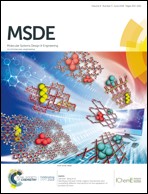
Mol. Syst. Des. Eng., 2019 April; 4:462-468
Shin, Y, Just-Baringo, X, Zarattini, M, Isherwood, L, Baidak, A, Kostarelos, K, Larrosa, I & Casiraghi, C
Liquid-phase exfoliation (LPE) of graphite shows great potential as a mass scalable and low-cost method for production of solution-processed graphene, which can be used for a wide range of applications. Due to the hydrophobic nature of graphene, a stabilising agent is needed to exfoliate graphite in water – in particular, pyrene derivatives have been shown to be very effective in exfoliating graphite, by producing either positively or negatively charged dispersions, depending on the functional group used. In this work we have synthesised amphoteric pyrene derivatives, using amino acid-based functional groups (lysine and taurine), and tested them as exfoliating agents for LPE of graphene. Atomic force microscopy shows the flakes to have an average size between 100 and 300 nm, while qualitative Raman analysis shows the dispersion to be composed mainly of single and few-layer flakes, as also confirmed by transmission electron microscopy. Finally, we demonstrate that the surface charge of graphene can be adjusted by a systematic change of the pH level. Although both stabilisers demonstrated to be able to exfoliate graphite in water, pyrene-based lysine produces more concentrated and stable graphene dispersions, whose surface charge changes between positive and negative depending on the pH level. In contrast, sedimentation of the dispersed material was observed at extreme pH for graphene dispersions obtained with pyrene-substituted taurine. This is attributed to the low pKa value of the sulfonic group in taurine, which remains negatively charged even at very low pH.
